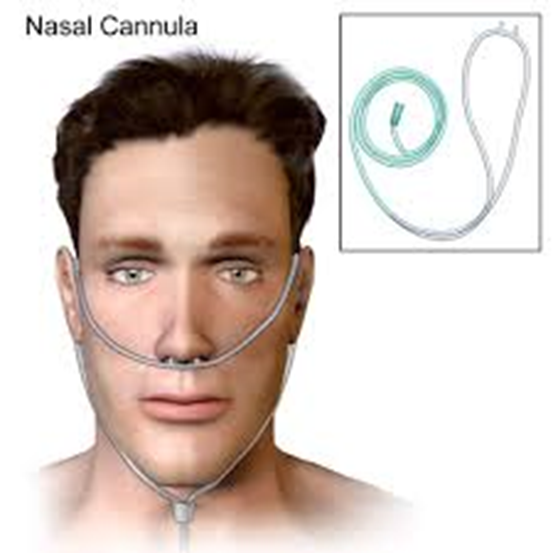A nurse is caring for a client who is receiving oxygen therapy via a nasal cannula. How should the nurse explain to the client how this method of oxygen delivery performs?
Delivers a low concentration of oxygen.
Delivers a constant rate of oxygen.
Delivers a high concentration of oxygen.
Delivers a constant flow of a specific concentration of oxygen.
The Correct Answer is D
Choice A Reason:
“Delivers a low concentration of oxygen” is incorrect because a nasal cannula can deliver varying concentrations of oxygen depending on the flow rate set by the healthcare provider. The concentration can range from low to moderate, typically between 24% to 44%.
Choice B Reason:
“Delivers a constant rate of oxygen” is partially correct but not entirely accurate. While the flow rate can be constant, the key aspect is the specific concentration of oxygen delivered, which is more relevant to the client’s understanding.
Choice C Reason:
“Delivers a high concentration of oxygen” is incorrect because nasal cannulas are generally used for low to moderate oxygen delivery. High concentrations of oxygen are typically delivered through other devices like non-rebreather masks or high-flow nasal cannulas.
Choice D Reason:
“Delivers a constant flow of a specific concentration of oxygen” is correct. This explanation accurately describes how a nasal cannula works. It provides a continuous flow of oxygen at a specific concentration, which is adjusted based on the client’s needs and the healthcare provider’s prescription.

Nursing Test Bank
Naxlex Comprehensive Predictor Exams
Related Questions
Correct Answer is D
Explanation
Choice A Reason:
“Call the provider” is important but not the first priority. The immediate concern is to maintain the client’s intravenous access to ensure they can receive any necessary medications or fluids promptly. Once the line is secured, the provider should be notified to receive further instructions and manage the client’s condition.
Choice B Reason:
“Notify the blood bank” is also crucial but comes after ensuring the client’s immediate safety. The blood bank needs to be informed to investigate the cause of the reaction and prevent further issues, but this step follows the initial emergency interventions.
Choice C Reason:
“Collect a urine specimen” is necessary to check for hemolysis, which can occur during a transfusion reaction. However, this is not the first step. The priority is to stabilize the client by maintaining IV access with normal saline.
Choice D Reason:
“Keep the line open with 0.9% NS through new tubing” is the correct first intervention. This action ensures that the client remains hydrated and that the IV line is available for any emergency medications or treatments. Using new tubing prevents any contamination from the transfusion set.
Correct Answer is A
Explanation
Choice A Reason:
Repeating auscultation after asking the client to take a deep breath and cough is the first intervention the nurse should take. This action helps to clear any secretions or mucus that might be causing the crackles. If the crackles persist after the client coughs, it indicates that the sounds are likely due to fluid in the lungs, which requires further assessment and intervention. This step ensures that the nurse accurately identifies the cause of the crackles before proceeding with other interventions.
Choice B Reason:
Instructing the client to limit fluid intake to less than 2,000 mL/day might be appropriate in cases of fluid overload or heart failure, but it is not the first intervention. The nurse needs to confirm the cause of the crackles before making any recommendations about fluid intake. Limiting fluid intake without proper assessment could lead to dehydration and other complications.
Choice C Reason:
Placing the client on bed rest in semi-Fowler’s position can help improve lung expansion and oxygenation by reducing pressure on the diaphragm. However, this is not the first intervention. The nurse should first determine if the crackles are due to secretions that can be cleared by coughing. Semi-Fowler’s position is beneficial for patients with respiratory distress, but it does not address the immediate need to reassess lung sounds.
Choice D Reason:
Preparing to administer antibiotics is not the first intervention. Antibiotics are used to treat infections, and the nurse needs to confirm whether the crackles are due to an infection or another cause before administering medication. Immediate administration of antibiotics without proper assessment could lead to inappropriate treatment and antibiotic resistance.
Whether you are a student looking to ace your exams or a practicing nurse seeking to enhance your expertise , our nursing education contents will empower you with the confidence and competence to make a difference in the lives of patients and become a respected leader in the healthcare field.
Visit Naxlex, invest in your future and unlock endless possibilities with our unparalleled nursing education contents today
Report Wrong Answer on the Current Question
Do you disagree with the answer? If yes, what is your expected answer? Explain.
Kindly be descriptive with the issue you are facing.
